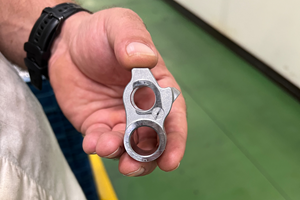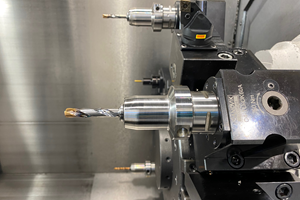How Do You Get The Cutting Parameters Right For Small End Mills?
A reader recently asked about speed, feed rate and depth of cut when using small tools in steel.
Share






A reader recently used the “Ask an Expert” feature of our Micromachining Zone to ask about realizing the correct cutting parameters when using small milling tools.
Question
I struggle with the speeds and feed rates for "small" ball end mills (0.03125, 0.040, 0.0625) when cutting our typical tool steels such as P-20, A2, and H13. We are limited to a maximum spindle speed of 15,000 rpm. Do you concentrate on the sfm for finish end mills of the same diameter, or do you consider that the center of the ball is going to push harder for a given feed per tooth? Then, when lace cutting, the stepover becomes my next challenge. When I do feel confident with my feed and speed, I am unsure of my stepover or depth of cut.
Response from John Bradford, micromachining R&D team leader for Makino
Your question is one we see commonly. I would like to assure you that although 15,000 rpm will limit your capabilities, you still have a reasonable range of performance on tools down to 1 mm or so in diameter. However, I think you will find that your maximum feed rates will be limited by that speed, since the bottom line really is maintaining consistent chip load. Tools smaller than 0.03125 inch will certainly need higher rpm for effective feed rate and surface finish.
I would like to address your question by considering three important factors, the most important of which is the first one:
1. Runout
I am assuming that when you say you struggle with these smaller cutters, you are experiencing premature cutter wear and breakage. For small cutting tool applications, the most serious problem I see is that people assume the tool tip, and therefore each cutting tool flute, is rotating with no runout. Generally, standard tools in standard toolholders only provide for a minimum tool tip runout of 0.0005 inch. This is not generally a problem with larger tools, but is devastating for small tools, and will result in premature tool breakage and poor surface finish. People tend to respond to this by slowing down the feed rate to reduce chip load.
Recommendations:
â—Ź If you are using collet holders, be aware that standard ER collets are not sufficient for providing runout of less than 0.010 mm. UP-style collets may get you down to 0.005 mm, but that is still too much. Look for ultra precision collet systems that have dynamic runout of 0.001 mm and below. (See this article.)
â—Ź Do not assume that the cutting flute is concentric with the shank of your tool. It is common to see flute runout of 0.010 mm or more relative to the tool shank. This is yet another issue that should be addressed, since it contributes to dynamic tool tip runout.
2. Cutting Tools
We typically recommend a carbide with TiCN or AlTiN coatings. For hardened materials, and for these small diameter tools, we recommend you do not use 4 flute cutters. Use 2 flute cutters, since the chip removal is much more efficient from the large gullet.
3. Depth of Cut
Generally, for carbide tools at small diameters, we use the following guidelines for maximum depths of cut:
â—Ź 30-40Hrc Materials—50% radial / 10% axial
â—Ź 41-50Hrc Materials—45% radial / 6% axial
â—Ź 51-60Hrc Materials—40% radial / 5% axial
For the corresponding chip load, although you should always check your tool supplier guidelines, I think you could use up to a 0.001 inch per tooth chip load to start. As a generic guideline, we recommend chip load relative to cutter diameter as follows:
Above 55Hrc
Roughing: 3% of cutter diameter
Semi: 2%
Finishing: 1%
Below 55Hrc
Rough: 5%
Semi: 3%
Finish: 1-2%
Related Content
The Future of High Feed Milling in Modern Manufacturing
Achieve higher metal removal rates and enhanced predictability with ISCAR’s advanced high-feed milling tools — optimized for today’s competitive global market.
Read MoreCustom PCD Tools Extend Shop’s Tool Life Upward of Ten Times
Adopting PCD tooling has extended FT Precision’s tool life from days to months — and the test drill is still going strong.
Read MoreForm Tapping Improves Tool Life, Costs
Moving from cut tapping to form tapping for a notable application cut tooling costs at Siemens Energy and increased tool life a hundredfold.
Read MoreToolpath Improves Chip Management for Swiss-Type Lathes
This simple change to a Swiss-type turning machine’s toolpath can dramatically improve its ability to manage chips.
Read MoreRead Next
AMRs Are Moving Into Manufacturing: Considerations for Implementation
AMRs can provide a flexible, easy-to-use automation platform so long as manufacturers choose a suitable task and prepare their facilities.
Read MoreMachine Shop MBA
Making Chips and 91ĘÓƵÍřŐľÎŰ are teaming up for a new podcast series called Machine Shop MBA—designed to help manufacturers measure their success against the industry’s best. Through the lens of the Top Shops benchmarking program, the series explores the KPIs that set high-performing shops apart, from machine utilization and first-pass yield to employee engagement and revenue per employee.
Read MoreLast Chance! 2025 Top Shops Benchmarking Survey Still Open Through April 30
Don’t miss out! 91ĘÓƵÍřŐľÎŰ's Top Shops Benchmarking Survey is still open — but not for long. This is your last chance to a receive free, customized benchmarking report that includes actionable feedback across several shopfloor and business metrics.
Read More




















